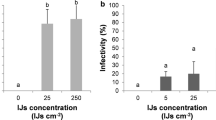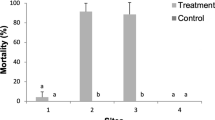Abstract
Two entomopathogenic nematodes,Steirnernema carpocapsae andS. feltiae were evaluated in the laboratory and under field conditions against larvae ofConorhynchus mendicus, a pest of sugar beet in the Gharb area of Morocco. Nematodes were applied in an artificially infested field using a knapsack sprayer either during the day or in the evening after sunset. The number of insect cadavers recovered from both soil and sugar beet plants was greater in the treated plots compared with the untreated ones. The percent reduction in live larvae was significantly greater in theS. carpocapsae treated plots (89.5% and 59.5% for night an day application respectively) compared with those treated withS. feltiae (68.5% and 28% respectively). The efficacy of entomopathogenic nematodes was therefore increased by application at night particularly in the case ofS. carpocapsae where control was maintained for 45 days.
Résumé
L'efficacité de deux espèces de nématodes entomopathogènes,Steinernema carpocapsae etS. feltiae a été testée au laboratoire et au champ contre les populations larvaires du cléone mendiantConorhynchus mendicus. Ce curculionide est l'un des ravageurs les plus importants de la betterave sucrière au Gharb (Maroc). Les nématodes entomopathogènes ont été appliqués au moyen d'un pulvérisateur manuel dans un champ artificiellement infesté, pendant le jour et pendant la nuit.
Les résultats obtenus montrent que le nombre de cadavres d'insectes récupéré était important dans les parcelles traitées comparé aux parcelles non traitées. Par ailleurs, la réduction des populations larvaires du ravageur était plus importante dans les parcelles traitées avecS. carpocapsae (89.5% et 59.5% respectivement pour l'application de nuit et de jour), que dans les parcelles traitées avecS. feltiae (68.5% et 28% respectivement).
L'efficacité des nématodes entomopathogènes s'est améliorée avec l'application de nuit particulièrement dans le cas deS. carpocapsae où le contrôle des larves était maintenu pendant 45 Jours.
Similar content being viewed by others
References
Balachowsky, A. S. — 1962. Entomologie appliquée à l'agriculture. Coléoptères 2.Masson et Cie. Paris.
Bedding, R. A., Molyneux, A. S. &Akhrust, R. J. — 1983.Heterorhabditis sp,Neoplectana sp andSteinernema kraussei interspecific differences in infectivity for insects.Exp. Parasitol. 55: 249–257.
Boselli, M., Curto, G. M., Tacconi, R., Pollini, A. & Santi, R. — 1994. Field trials withSteinernema carpocapsae andHeterorhabditis sp. juveniles against the sugarbeet weevil,Conorhynchus mendicus Gyll., in Italy.Nematologica, 463–465.
Boselli, M., Curto, G. M. & Lazzari, G. L. — 1991. Monoitoraggio del cleono della barbabietola da zucchero (Temnorrhinus mendicus Gyll.) (Coleoptera Curculionidae) e prove preliminari di lotta con nematodi entomopatogeni.Informatore Fitopatologico, 7–8.
Deseö, K. V. — 1987. Entomoparasitic nematodes in the control of curculionids. Microbial control of weevils and environmental persistence of pathogens and nematodes.WPRS Bulletin, XII, 4, Versaille, 2–4 Septembre.
Edwards, C. A. &Oswalds, J. — 1991. Control of soil inhabiting arthropods withNeoplectana carpocapsae. Proceeding of the British Crop Protection Conference.Pests and Diseases Vol 2: 467–473.
Felsot, A. S. — 1989. Enhanced biodegradation of insecticides in soil: Implication for agroecosystems.Ann. Rev. Entomol., 24, 453–476.
Gaugler, R. — 1988. Ecological considerations in the biological control of soil inhabiting insects with entomopathogenic nematodes.Agric., Ecosyst. Environ., 24, 351–360.
Gaugler, R. &Boush, G. M. — 1979. Non susceptibility of rats to the entomopathogenic nematode,Neoplectana carpocapsae.Environ. Entomol., 8, 658–660.
Gillet, H. — 1991. Résidus dans l'eau: quelques matières actives plus préoccupantes.Cultivar, 308, 36–38.
Gwynn, R. L. & Richardson, P. N. — 1994. Growth of severalXenorhabdus andPhotorhabdus spp. isolates at low temperatures: In Microbial Control of Pests. 4th European Meeting (P. H. Smiths, eds).IOBC bulletin, 120–123.
Kaya, H. K. — 1990. Soil ecology, In Entomopathogenic nematodes in biological control. (R. Gaugler &H. K. Kaya (eds))CRC, Boca Raton, FL; 93–115.
Kaya, H. K. &Gaugler, R. — 1993. Entomopathogenic nematodes.Ann. Rev. Entomol., 38, 181–206.
Klein, M. G. — 1988. Pest management of soil inhabiting insects with microorganisms.Agric., Ecosyst. Environ., 24, 337–349.
Koch, F. — 1991. Bewertung der phytopathologischen situation im zuckerrubbenabau Marokkos, band 1;Rapport GTZ, 41 p.
Messaoudi, M. — 1994. Mole drainage in the heavy clay soils of the Gharb region (Morocco).Ph.D. thesis, University of Cranfield, 256 p.
Rutherford, T. A., Trotter, D. &Webster, J. M. — 1987. The potential of Heterorhabditid nematodes as control agents of root weevils.Can. Entomol., 119, 67–73.
Poinar, G. O., Thomas, G. M., Presser, S. B. &Hardy, J. L. — 1982. Inoculation of entomogenousNeoplectana andHeterorhabditis and their associated bacteriaXenorhabditis spp. into chicks and mice.Environ. Entomol., 11, 137–138.
Pussemier, L. — 1990. Some factors affecting the accelerated biodegradation of carbofuran in sugar beet cultivation of central Belgium. Monograph.British Crop Protection Council, 47, 59–65.
Pussemier, L. — 1991. Accelerated degradation of Carbofuran in soil of sugar beet cultivation.Mededelingen van de Faculteit Landbouwetenschppen, Rijksuniversiteit Gent, 55, 3b, 1301–1306.
Shroeder, W. J. — 1987. Laboratory bioassays and field trials of entomogenous nematodes for control ofDiaprepes abbreviatus (Coleoptera: Curculidae), in Citrus.Environ. Entomol., 16, 987–989.
Wright, R. G., Witkowski, J. F., Echtenkamp, G. &Georgis, R. — 1993. Efficacy and persistence ofSteinernema carpocapsae (Rhabditida: Steinernematidae) applied through a center pivot irrigation system against larval corn rootworms (Coleoptera: Curculionidae).J. Econ. Entomol., 86, 1348–1354.
Author information
Authors and Affiliations
Rights and permissions
About this article
Cite this article
Akalach, M., Wright, D.J. Control of the larvae ofConorhynchus mendicus (Col.: curculionidae) bySteinernema carpocapsae andSteinernema feltiae (nematoda, steinernematidae) in the gharb area (Morocco). Entomophaga 40, 321–327 (1995). https://doi.org/10.1007/BF02373719
Received:
Accepted:
Issue Date:
DOI: https://doi.org/10.1007/BF02373719




